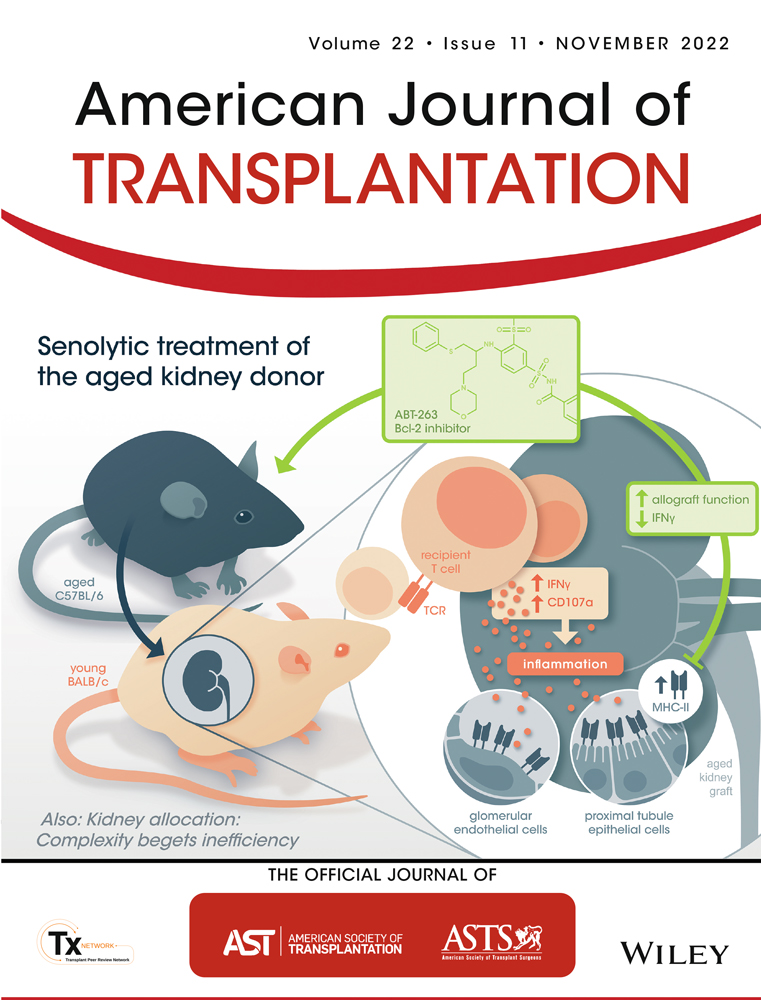Gene expression profiling using deceased donor kidney biopsies to predict graft outcomes—We are not there yet
Abstract
This editorial critically reviews the manuscript by Archer (page 2515) which describes the derivation of a risk calculator for post-transplant allograft function by gene expression profiling of deceased donor kidney biopsies.
Abbreviations
-
- GFR
-
- glomerular filtration rate
-
- KDPI
-
- Kidney Donor Profile Index
The field of organ transplantation has seen enormous developments in creating and validating new biomarkers or composite risk scores as prognostic tools to predict graft outcomes.1 Most of these tools rely on findings or events after transplantation, and the field would benefit greatly from a reliable prognostic method to identify high-risk patients already at the time of transplantation. Although risk predictors already exist to evaluate deceased donor quality, most importantly the Kidney Donor Profile Index (KDPI), these predictors fail to categorize all risk donors adequately, with serious consequences in the current context of organ shortage.2
In the current issue, Archer et al describe the development of a transcriptomic tool for evaluating deceased donor organ quality.3 In their study, a training set of 174 deceased donor pretransplant biopsies was used to assess the utility of pretransplant gene expression profiles in predicting 24-month outcomes after kidney transplantation. Gene expression for a subset of candidate genes was then measured in an independent set of 96 pretransplant biopsies, and a risk calculator was created using 13 genes and three donor characteristics (age, race, BMI), with good predictive performance, outperforming e.g., KDPI. Interestingly, kidneys with low function showed upregulated innate and adaptive immune responses already prior to transplantation, and downregulation in metabolic functions. The strengths of the study include the relatively large prospective multicenter cohort with 2-year graft function as the outcome and including data on graft survival data also for longer follow-up. Although the concept of studying gene expression profiles in deceased donor kidney biopsies is not entirely novel, the authors should be commended for their extensive work in the study.
There are, however, some caveats in interpreting the findings and drawing conclusions based on the data presented. A dichotomous outcome of eGFR <45 ml/min was used for defining low graft function, creating arbitrarily more statistical power to the analyses, despite the clinical relevance of this exact cut-off may be questionable. Indeed, eGFR is used as a surrogate endpoint to reflect a hard endpoint (graft failure), but there is evidence that the trajectory or the slope of eGFR has more predictive value and better reflects what is observed in clinical practice.4 In addition, the model did not find good concordance between paired kidneys from the same donor, casting some doubt in the generalizability of the findings. Surprisingly, some well-known parameters from the literature, such as cold ischemia time or preformed circulating anti-HLA donor-specific antibodies, were not independently associated with the outcome in the multivariable analysis and therefore not included in the final model. Finally, some important metrics to characterize the clinical performance and added value of the model, such as calibration and decision curve analyses as recommended by the TRIPOD guidelines,5 were not reported.
In the past two decades, we have seen an enormous inflation in development and publication of risk calculators in the medical literature, with the vast majority of them having little or no clinical relevance after their publication. Mostly these studies give us information on model performance but fail to tell us whether the actual use of the models would be beneficial in clinical practice or would help in improving outcomes such as graft survival. Some recent reports describe common problems shared with many risk calculators,6 practices that have exploded especially during the COVID-19 pandemic,7 such as using an endpoint without clinical significance or association with hard endpoints, key elements, and potential confounders associated with the outcome not included in the analyses, and lack of reporting of calibration, which all also apply to the current study.
The use of transcriptomics has greatly increased our understanding of the different ongoing molecular processes in transplanted organ and is continuously translating to exploration of better ways to improve the transplant outcomes and precision diagnostics. However, instead of only focusing on finding new biomarkers and risk scores for predicting outcomes, we should focus on validating and qualifying the existing ones better, to be able to translate this information to decision making and interventions in improving the outcomes in clinical practice. Thus, investigating new biomarkers should be driven by the goal of doing better than what already exists in clinical practice and in the literature, while respecting the highest methodological standards. The current study by Archer et al helps us understand early transplant outcomes and biological processes, but more work needs to be done to make these results clinically impactful.
DISCLOSURE
The authors of this manuscript have conflicts of interest to disclose as described by the American Journal of Transplantation. I.H. holds research funds from MSD and Hansa Biopharma, is receiving consultancy honoraria from Novartis, Hansa Biopharma, and Takeda, and is an associate editor for American Journal of Transplantation. G.D. received grants from the French Foundation for Medical Research and the French-Speaking Society of Nephrology, Dialysis, and Transplantation.




